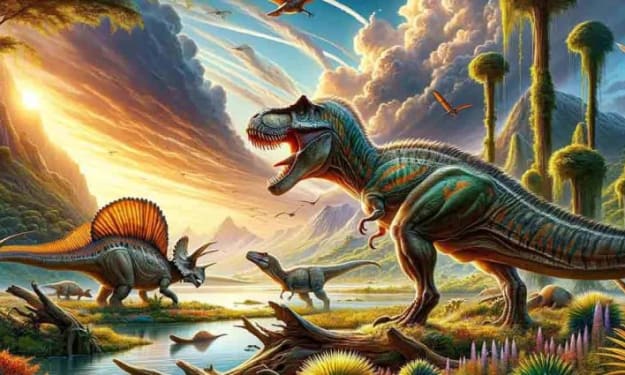The Top 15 Tectonic Phenomena of the Earth's Dynamic Forces
Tectonic Phenomena

The Earth is a dynamic, ever-changing globe that has been sculpted by enormous geological processes that have been at work for millions of years. Tectonic activities, which include the movement of the Earth's crust, earthquakes, and the production of distinctive geological features, are among the most fascinating and influential phenomena. In this blog, we'll look at the top 15 tectonic occurrences from across the world, emphasizing their relevance and the unique insights they bring into the past and future of our planet.
15. The East African Rift: Witnessing Continental Drift in Action
The East African Rift is a live monument to the Earth's continuing migration of land masses. The African plate's active Rift Zone is divided into two plates: the Somali plate and the Nubian plate. The process began between 22 and 25 million years ago, and its consequences may be seen at ground level. A series of earthquakes in Kenya in 2018 produced the formation of large fractures in the ground, indicating the border where the tectonic plates may finally separate. This continuing process provides a unique look into the steady evolution of our planet's landscape.
14. Tepehan, Turkey: Earthquake Consequences Unveiled
The 2023 earthquake near the Turkish-Syrian border demonstrated the vast force and catastrophic potential of seismic occurrences. Aside from the devastating loss of life and widespread devastation, the earthquake caused a massive split in the ground that was 984 feet long, 165 feet broad, and 130 feet deep. This striking reminder of the Earth's raw force emphasizes the importance of earthquake preparedness and infrastructure resilience in earthquake-prone areas.
13. Ridgecrest, California: Unexpected Consequences of Seismic Activity
In 2019, a severe earthquake series struck Ridgecrest, California, causing people to be astonished by the emergence of a large fracture running over the Mojave Desert. While the US Geological Survey determined that this was not a new fault line, it did highlight the potential impact of earthquakes on the Earth's surface. It also acted as a warning for the famed San Andreas fault, which has the potential to cause a devastating earthquake.
12. Lake Tanganyika: A Rift's Creation and Life's Support
Lake Tanganyika, the world's second-largest freshwater lake, has a secret: its origins are in the tectonic movement of the Earth's crust. This huge rift, formed by the East African Rift, has steadily deepened due to earthquakes, forming an important ecosystem sustaining diverse aquatic species. The water from the lake flows into the Congo River system, revealing how geological processes alter entire landscapes and ecosystems.
11. Palu City, Indonesia: Earthquake, Tsunami, and Liquefaction
The 2018 earthquake in Palu, Indonesia, had three disastrous repercussions. The initial earthquake caused both a tsunami and soil liquefaction. During an earthquake, saturated ground briefly behaves like a liquid, causing buildings to sink or collapse. This occurrence emphasized the intricate interplay of geological and environmental elements in determining disaster outcomes.
10. The Japan Trench: Deep-Seated Hazards and Research Opportunities
The Japan Trench is an oceanic trench off Japan's eastern coast in the Pacific Ocean that represents a volatile subduction zone where tectonic plates meet and generate enormous seismic activity. The trench's importance in seismic hazard assessment was highlighted by the devastating 2011 Tohoku earthquake and tsunami. Scientists investigate the trench to learn more about subduction zones, fault movements, and tsunami generation.
9. The Silfra Rift: Exploring the Seam Between Continents
Iceland's Silfra Rift demonstrates the tremendous impacts of tectonic plate movement. Divers can swim between the North American and Eurasian plates, literally separating continents. This breathtaking location emphasizes the continuous separation of tectonic plates and provides insights into the dynamic processes forming the surface of our planet.
8. The Motagua Fault: Unveiling Central America's Active Tectonics
The Motagua Fault in Central America exemplifies the region's vigorous tectonic processes. It is a large strike-slip fault that contributes significantly to seismic activity in Guatemala and Honduras. The history of strong earthquakes on the fault emphasizes the significance of monitoring and preparedness in earthquake-prone locations.
7. The Kakarapang Fault: A Reminder of Active Earth's Forces
Karapang Fault, which runs the length of New Zealand's South Island, is evidence of continuous tectonic activity. Significant earthquakes were triggered by strike-slip movement along this fault, notably the 2016 event, which changed the landscape and demonstrated the might of geological processes. The scars and features of this fault provide crucial information about past earthquake occurrences.
6. The Gulf of Corinth Sinkholes: Unveiling the Hidden Dangers
While earthquakes aren't normally linked with Croatia, the 2021 incident created a series of sinkholes in unexpected places. These sinkholes originated as a result of the combination of limestone rock weakness and post-earthquake water infiltration. This occurrence emphasized the intricate interplay between geological and environmental elements in the formation of surface features.
5. Reelfoot Lake: Nature's Response to Earth's Tremors
The geography of Reelfoot Lake in Tennessee is a fascinating example of how earthquakes may affect landscapes over time. This lake was formed in the early nineteenth century by a series of strong earthquakes, transforming what was formerly dry land into a unique aquatic habitat. Reelfoot Lake demonstrates how seismic activity can create spectacular natural features while reshaping the ground.
4. The Bhuj Earthquake: Unleashing Devastation and Insights
The 2001 Bhuj earthquake in India illustrated the devastation that tectonic earthquakes may bring. It left a devastation trail and exposed the vulnerability of heavily inhabited areas. The event sparked an international response, emphasizing the importance of disaster preparedness, infrastructure resilience, and humanitarian help in the aftermath of severe earthquakes.
3. Lake Baikal: A Geological Marvel and Biodiversity Hub
Lake Baikal, sometimes known as the "Pearl of Siberia," is the world's deepest and oldest freshwater lake. Its formation demonstrates the tectonic forces at work in Siberia. The lake's distinct history and richness demonstrate how geological events can generate ecosystems that support life, providing significant insights into the Earth's complex interaction of processes.
2. The Weber Deep: Earth's Abyss and Subduction Zone
The Weber Deep, located in the Banda Sea in Indonesia, is a witness to the Earth's enormous depths and tectonic activity. The continual collision of tectonic plates has sculpted this massive depression, resulting in earthquakes and deep-sea trenches. Despite its isolated position, Weber Deep provides a unique home for a wide range of deep-sea species and gives scientists with vital insights into the inner workings of the Earth.
1. Northeast Croatian Sinkholes: When Quakes Leave Cracks Behind
The unprecedented emergence of sinkholes in Croatia following the 2020 earthquake illuminated the complicated interaction of geological forces and environmental factors. These surprising structures, formed by limestone rock erosion, acted as a harsh reminder of the Earth's ability to modify its surface in unexpected ways. The sinkholes demonstrated the need to comprehend and reduce the effects of seismic activity.
Conclusion
The Earth's tectonic phenomena never fail to astound us, from the huge chasms of the East African Rift to the unknown depths of the Weber Deep. These dynamic processes shape our environment, forming beautiful landscapes, encouraging biodiversity, and reminding us of the planet's strength. We get a better knowledge of our planet's past, present, and future by researching these occurrences, while also preparing ourselves for the difficulties and possibilities that tectonic forces provide.
About the Creator
Enjoyed the story? Support the Creator.
Subscribe for free to receive all their stories in your feed. You could also pledge your support or give them a one-off tip, letting them know you appreciate their work.





Comments
There are no comments for this story
Be the first to respond and start the conversation.